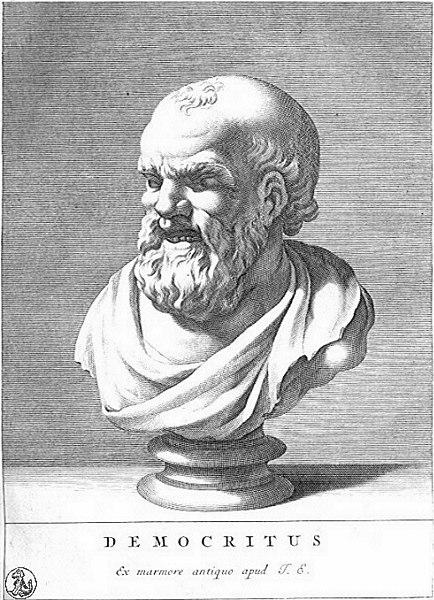Basically nothing.
There was much conjecture about what the world was possibly made and amazingly through the work of the al-chemists humans gained amazing blind facility with creating new molecules from their very scant understanding of how elements could be mixed in measure to induce various reactions but little was really known about what exactly matter was made up of.
Of course going back to the Greeks the idea of what it was made up of was given by smart people like Democritus who stated:
"The more any indivisible exceeds, the heavier it is."
Well that settles the matter doesn't it? Well not really, the conception of atoms that the ancients had was a bit different from that put forward by modern thinkers, but the general idea of spherical elements interacting in large amounts to constitute the macroscopic materials of which they were made is clear. The problem was is that no one was able to *prove* that this was so, even Newton used the conception only so far as it was useful to allow him to create measures for describing his idea of optics but that didn't rely on any real understanding of the light being made up of particles (or as he called them "corpuscles").
A bit later the Roman Lucretius stated this wrote this incredibly prescient statement:"Observe what happens when sunbeams are admitted into a building and shed light on its shadowy places. You will see a multitude of tiny particles mingling in a multitude of ways... their dancing is an actual indication of underlying movements of matter that are hidden from our sight... It originates with the atoms which move of themselves [i.e., spontaneously]. Then those small compound bodies that are least removed from the impetus of the atoms are set in motion by the impact of their invisible blows and in turn cannon against slightly larger bodies. So the movement mounts up from the atoms and gradually emerges to the level of our senses, so that those bodies are in motion that we see in sunbeams, moved by blows that remain invisible."
However, this is incorrect as dust particles have their chaotic motions controlled by wind currents than by the bombardments of individual atoms.
Nearly 2000 years later, JJ Thompson added some solidity to the idea of atoms by harnessing the electrons which we know today are part of atoms and are the constituent particle of electrical current flows. He won the Nobel prize in 1906 for his work in describing the ratios by which current flows could be deflected using electric fields.
"
Thomson believed that the corpuscles emerged from the atoms of the trace gas inside his cathode ray tubes. He thus concluded that atoms were divisible, and that the corpuscles were their building blocks. To explain the overall neutral charge of the atom, he proposed that the corpuscles were distributed in a uniform sea of positive charge; this was the "plum pudding" model—the electrons were embedded in the positive charge like plums in a plum pudding (although in Thomson's model they were not stationary, but orbiting rapidly). "
However, note he didn't win that prize until after Einstein's miracle year, it's difficult to suppose why but in many ways Brownian motion wasn't just about determining that atoms existed. It was pretty much agreed that they did, but formalizing how their masses varied and how that could be inferred from group dynamics was wide open. Thus the real power revealed by Einstein's theory is summarized by this passage in the Brownian motion article at wikipedia:
" But Einstein's predictions were finally confirmed in a series of experiments carried out by Chaudesaigues in 1908 and Perrin in 1909. The confirmation of Einstein's theory constituted empirical progress for the kinetic theory of heat. In essence, Einstein showed that the motion can be predicted directly from the kinetic model of thermal equilibrium. The importance of the theory lay in the fact that it confirmed the kinetic theory's account of the second law of thermodynamics as being an essentially statistical law. "
So, the power of Einstein's theory was that it used thermodynamic means to infer atomic presence and attributes such as mass. So what ?
Thermodynamic analysis allowed Einstein's theory to refine the methods by which chemistry could measure the size of molecules of various types.
" This result enables the experimental determination of Avogadro's number and therefore the size of molecules. Einstein analyzed a dynamic equilibrium being established between opposing forces. "
This is a *huge* result as it allowed molecular chemistry to proceed forward at a pace that it had not yet achieved prior to application of these methods to determine precise measures of necessary components and percentages to creating new molecules. It would be at least another 20 years before the full truth of atoms and their chemistry important subatomic constituents would be fully revealed but explaining Brownian motion took Chemistry mostly from a guess work Science to one of precision. The 20's, 30's and 40's stand testament to the revolution that was enabled by understanding at a molecular level what atoms were doing and how they could be combined.
Companies like DuPont, Bayer, BASF, Dow Chemical should ring a bell as much of their innovations in the 30's and 40's that fueled the war efforts on both sides of the planet were induced by innovations in artificial molecules that were made possible by the more refined chemical fidelity enabled by fully understanding the interactions of atoms. From Nylon to Polyurethane to Polyester exist because of this innovation, considering that you are likely wearing clothes that contain one of these substances as you read this it stands testament to how extensive Einstein's theory was.
Links:http://en.wikipedia.org/wiki/Brownian_motion
http://www.caimateriali.org/index.php?id=32
http://en.wikipedia.org/wiki/On_the_Nature_of_Things
http://en.wikipedia.org/wiki/Democritus
http://en.wikipedia.org/wiki/JJ_thomson
http://en.wikipedia.org/wiki/Avogrado%27s_number
http://en.wikipedia.org/wiki/Polyurethane
http://en.wikipedia.org/wiki/Nylon




Comments